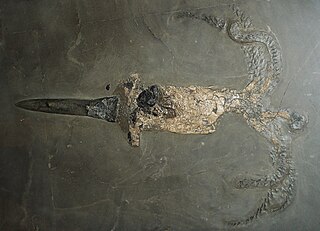
Belemnoids are an extinct group of marine cephalopod, very similar in many ways to the modern squid and closely related to the modern cuttlefish. Like them, the belemnoids possessed an ink sac, but, unlike the squid, they possessed ten arms of roughly equal length, and no tentacles. The name "belemnoid" comes from the Greek word βέλεμνον, belemnon meaning "a dart or arrow" and the Greek word είδος, eidos meaning "form".

Edward Oscar Ulrich was an invertebrate paleontologist specializing in the study of Paleozoic fossils.
Plioplatecarpinae is a subfamily of mosasaurs, a diverse group of Late Cretaceous marine squamates. Members of the subfamily are informally and collectively known as "plioplatecarpines" and have been recovered from all continents, though the occurrences in Australia remain questionable. The subfamily includes the genera Latoplatecarpus, Platecarpus, Plioplatecarpus and Plesioplatecarpus.
Prionoceratinae are one of six subfamilies of the Prionoceratidae family, a member of the Goniatitida order. They are an extinct group of ammonoid, which are shelled cephalopods related to squids, belemnites, octopuses, and cuttlefish, and more distantly to the nautiloids.
Dunbaritidae is one of six families of the Somoholitoidea superfamily. They are an extinct group of ammonoid, which are shelled cephalopods related to squids, belemnites, octopuses, and cuttlefish, and more distantly to the nautiloids.
Pericycloceratidae is one of eleven families of the Neoicoceratoidea superfamily. They are an extinct group of ammonoid, which are shelled cephalopods related to squids, belemnites, octopuses, and cuttlefish, and more distantly to the nautiloids.

Flowers for Algernon is a short story by American author Daniel Keyes, later expanded by him into a novel and subsequently adapted for film and other media. The short story, written in 1958 and first published in the April 1959 issue of The Magazine of Fantasy & Science Fiction, won the Hugo Award for Best Short Story in 1960. The novel was published in 1966 and was joint winner of that year's Nebula Award for Best Novel.
Acrocoelites is a genus of belemnite, an extinct group of cephalopods.
Gonioteuthis is a genus of belemnite, an extinct group of cephalopods. It grew to a body length of 8 inches and fed on small marine animals. Fossils of Gonioteuthis have been found in the Netherlands, Germany, and Sweden in rocks dated to the late Cretaceous Period, specifically 85 to 70 million years ago.
Hematitida is a group of coleoid cephalopods known from the early Carboniferous Period. They are the oldest definite coleoids, although there are controversial claims for even older coleoids from the Devonian. Fossil hematitidans have so far been found only in Arkansas and Utah of the United States. The only family described so far is Hematitidae.

Belemnitida is an extinct order of squid-like cephalopods that existed from the Late Triassic to Late Cretaceous. Unlike squid, belemnites had an internal skeleton that made up the cone. The parts are, from the arms-most to the tip: the tongue-shaped pro-ostracum, the conical phragmocone, and the pointy guard. The calcitic guard is the most common belemnite remain. Belemnites, in life, are thought to have had 10 hooked arms and a pair of fins on the guard. The chitinous hooks were usually no bigger than 5 mm (0.20 in), though a belemnite could have had between 100 and 800 hooks in total, using them to stab and hold onto prey.

Belemnites is a genus of an extinct group of cephalopods belonging to the order Belemnitida. These cephalopods existed in the Early Jurassic period from the Hettangian age to the Toarcian age (175.6–183.0). They were fast-moving nektonic carnivores.

The Peedee Formation is a geologic formation in North and South Carolina. A marine deposit, named for exposures along the Great Peedee River, it preserves belemnites and foraminifera fossils dating from the Late Cretaceous. The formation is notable for its occurrence of Belemnitella americana, known as the Pee Dee Belemnite (PDB), a long-standing standard in stable carbon isotope research.

The Charmouth Mudstone Formation is a geological formation in England. It preserves fossils dating back to the early part of the Jurassic period (Sinemurian–Pliensbachian). It forms part of the lower Lias Group. It is most prominently exposed at its type locality in cliff section between Lyme Regis and Charmouth but onshore it extends northwards to Market Weighton, Yorkshire, and in the subsurface of the East Midlands Shelf and Wessex Basin. The formation is notable for its fossils, including those of ammonites and marine reptiles and rare dinosaur remains. The formation played a prominent role in the history of early paleontology, with its Lyme Regis-Charmouth exposure being frequented by fossil collectors including Mary Anning.
The Staffin Bay Formation is a geologic formation in Scotland. It preserves fossils dating back to the Callovian of the Middle Jurassic. It consists of two members, the lower Upper Ostrea Member, which consists of dark grey, fissile mudstone with a shelly limestone bed, and laminated and rippled sandstones. While the upper Belemnite Sands Member consists of medium grained calcareous sandstones and siltstones
The Calcaire à Bélemnites is a geologic formation in France. It preserves fossils dating back to the Jurassic period.
The Köpinge Sandstone is a highly calcareous and glauconitic sandstone geologic formation of the Vomb Trough in Skåne, southernmost Sweden. The formation dates to the latest early to middle late Campanian stage of the Late Cretaceous and has provided fossils of ammonites, belemnites, the shark Cretalamna borealis and the mosasaurid Tylosaurus, originally described as Hainosaurus. Ex situ occurrences in Pleistocene deposits have provided a dorsal vertebra of a possible elasmosaurid.
Sinognathus is an extinct genus of gomphodont cynodonts from the Middle Triassic Ermaying Formation of China. Its type and only species is Sinognathus gracilis, which was named in 1959 by the Chinese palaeontologist C. C. Young.






